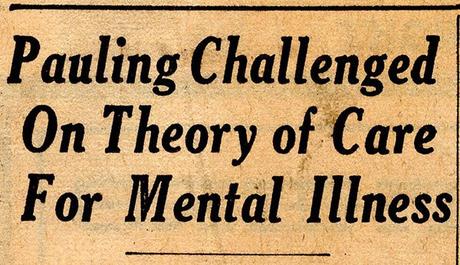
[Part 6 of 10]
“Even in the starchiest Establishment criticism, there lurk phrases or hints that just maybe Linus and his buddies have something – if only they would get their ducks of scientific proof in line. Lest the future catch a critic out, no one wants to say Pauling is dead flat wrong.“
-Barbara Yuncker, New York Post, October 25, 1974
As with the scientific community, Pauling’s work on schizophrenia experienced a mixed reception in the media, with some commenters offering acclaim and others classifying the approach as inappropriate or even harmful. Perhaps unsurprisingly, Pauling found much of the negative press to be a misrepresentation of his or his colleagues’ work, and he did not shy away from fighting back, both in public and in private. In doing so he was seeking, of course, to maintain and uphold his image as a legitimate scientific researcher, but also to guard against the derailment of a therapy that he felt had great potential for improving the lives of many patients suffering from a terrible affliction.
One notable entanglement with a publication came in 1975 and centered around a Medical World News article titled, “Megavitamins and Mental Disease: Useful Therapy or Wishful Thinking?” Pauling found many of its claims to be wildly inaccurate and wrote to the publication’s editor, Howard Cohn, to express his objections. One of Pauling’s biggest complaints was the article’s assertion that, in a two-year double-blind study conducted by Rutgers University psychologist Richard Wittenborn, schizophrenia patients treated with niacin had experienced an “alarming side effect.” In actual fact, the observed side effect was nothing more than a mild skin rash that quickly dissipated.
For Pauling, this willingness to sensationalize “probably misled some [readers] into accepting a wrong conclusion about the toxicity of niacin.” In addition, “there is no certainty that even this benign and transient effect is a side effect of niacin [because no other] psychiatrists who have given megadoses of niacin to thousands of patients over very long periods of time” had reported a similar finding. In his letter to Cohn, Pauling asked that Medical World News publish his objections as well as a retraction. The editor responded that he was unable to publish Pauling’s defense, “owing to inevitable space limitations.”
Pauling remained intent on correcting misrepresentations of orthomolecular therapy in the media, and was also keen on collecting reports that pointed out the inefficiencies of more traditional schizophrenia therapies. For example, Pauling saved and highlighted a June 27, 1979 San Francisco Chronicle piece titled, “Shock Therapy – Not as Bad as it Sounds?” Despite its title, the article’s author notes that shock therapy is oftentimes not effective, and that as many as thirty percent of treated patients “are just not having any response.” Pauling believed that his approach might offer a solution for those thirty percent, as well as many others who responded more favorably to a therapy that, regardless of its benefit, still posed the threat of multiple side effects.
There were, however, moments where the press responded more favorably to Pauling’s perspective. In 1968, shortly after Pauling published his first article on the subject, the San Diego Union reported that “one of the country’s ablest chemists” had put forth an idea that was “quite promising.” As time moved forward and criticisms began to emerged, other newspapers offered more cautiously positive assessments. In one instance, published in April 1973, a San Jose Mercury staff writer noted Pauling’s belief that the controversy surrounding his schizophrenia work would lead to “more thorough clinical tests which…will confirm [his] claims.”
Supporters also took to the papers to press their case. One reader, Rae Irene Plick, wrote to the editor of the New Jersey Star-Ledger to express dissatisfaction with recent negative coverage of Pauling’s work. Plick made clear that she had personally benefited from megadosing therapy and, as a result, knew firsthand how effective it could be. “[F]or those of us whose families have experienced success with megavitamin therapy,” she wrote, “we can only shake our heads sadly to think of all the patients who are being deprived of this modality of treatment by so-called traditional psychiatrists.”
A higher-profile writer who likewise offered support was Barbara Yuncker, an award-winning science journalist and editor. In an October 1974 New York Post piece titled “Schizophrenia: New Treatment,” Yuncker praised Pauling’s efforts. Though acknowledging that “megavitamin therapy … has never moved into the mainstream of mental illness therapy” the concept was almost two decades old and “has been adopted by a few doctors and some patients and their families with a fervor akin to that of Bible Belt Fundamentalists.” Yuncker was clear that all credit for this rise in popularity – even modest though it may be – should rest solely with Pauling and his “unquenchable gadfly energy.” Yuncker further noted that
the critics may – and do – call orthomolecular medicine offbeat, far-out, insufficiently proven experimentally, questionable in some of its methodology – in short, a bit wacky. But they can’t – and don’t – call it quackery.
The “they,” in this case, was the “Establishment,” which was firmly against Pauling. More specifically, Yuncker pointed out that federal bodies were discouraging the use of megavitamins and that the American Psychiatric Association had formally decried Pauling’s approach. But for Yuncker, what mattered most was that the research was based in legitimate science and often seemed to be effective. These were reasons enough to keep the conversation about orthomolecular psychiatry alive.
